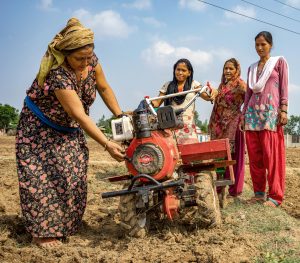Maize and wheat harvests keep pace despite the pandemic

Despite COVID-19 pandemic disruptions and extreme weather events, maize and wheat farmers in Africa, Asia, and Latin America were mostly able to salvage good harvests from their 2020 crops.
Smallholders overcame many challenges, including the high costs and shortages of field labor, qualms about hiring outside field workers, and being cut off from inputs, credit, or technical support, according to Jelle Van Loon, International Maize and Wheat Improvement Center (CIMMYT) mechanization specialist in Latin America.
“Some rural communities in Mexico closed off completely for fear of COVID, with farmers reluctant to attend to more than their basic needs, avoiding risks and minimizing long-term plans,” Van Loon said, “but household members did go to the field and work, aware that the grain they produced might prove critical if food supplies grew short and more expensive.”
Erratic rains during the onset of the pandemic, coinciding with the start of the main cropping season, caused smallholder farmers in Mexico, who generally lack irrigation, to behave conservatively, Van Loon explained.
“This and a month-long drought that killed many early-sown maize crops forced farmers to adjust to the ‘new normal’ and plant again when the rains came back,” he added. “In the meantime, cell phones and social media applications have proven vital for farmers to stay in touch and conduct business during the pandemic, allowing access to technical and administrative support and even the online purchase of inputs.”
In Africa, COVID-related lockdowns impeded the movement of rural inhabitants who, in addition to farming, depend on trade, part-time jobs as crafts persons and artisans, and small-scale mining. “Off-farm income is a mainstay of rural households in Africa,” observed Frédéric Baudron, CIMMYT systems agronomist based in Zimbabwe.
What it takes to keep farming going

In South Asia’s extensive maize and wheat lands, particularly in Bangladesh and northern India, excess rainfall and powerful typhoons flooded fields early in the cropping season. However, COVID-19 disrupted agriculture in new, diverse ways, according to T.S. Amjath-Babu, CIMMYT agricultural economist based in Bangladesh.
“International and domestic supply chains for fertilizers, agrochemicals, machinery, and seeds have been impeded by import and movement restrictions,” Amjath-Babu said. “Stay-in-place orders and limitations on migration have created labor shortages, and social distancing hinders farm operations.”
In northern India, where 2.4 million farmers grow variations of the rice-wheat cropping rotation, researchers had feared that the COVID-19 lockdown would delay rice sowing and disrupt the fine-tuned cropping system. Worst-case scenarios forecast economic losses of nearly $1.5 billion and more severe pollution from the late burning of rice straw. Fortunately, technologies that CIMMYT had refined for decades with national partners, along with policies to promote them, helped ward off the worst effects of the crisis.
In a recent study, Amjath-Babu and colleagues concluded that if the COVID-19 crisis lasts longer than many expect, resilient food systems will require stable supply chains, infection-free logistics, extended social safety nets, adequate credit facilities, innovative labor management, and appropriate farm mechanization.
Mechanization turns the wheels of small-scale farming
To mitigate labor shortages and make agriculture more manageable, CIMMYT has been testing and promoting scale-appropriate farm machinery for smallholder maize and wheat farmers.
“We facilitate and promote farmers’ acquisition and use of the right equipment, along with business models whereby those who already own machinery offer services to farmers for land preparation, planting, irrigation, harvesting, processing, and other activities,” said Timothy Krupnik, systems agronomist and CIMMYT country representative in Bangladesh. “This is a win-win situation for farmers who can’t access or afford field laborers, and allows crucial farm work to take place while maintaining social distancing.”
The use of small machinery lowers production costs and relieves pressure on available labor, Krupnik explained. “In a COVID-altered world, this will remain an essential support for food production in rural areas, particularly by the growing number of women-headed households, as the outmigration of working-age men increases.”
Developing and fostering use of appropriate mechanization is just one way CIMMYT helps pandemic-stricken farmers, according to Van Loon. “We continue to spread sustainable intensification technologies and practices, including cropping diversification, better post-harvest management of grain, business model development, and the targeted use of fertilizers and improved varieties.”
Partners and funders
In Africa, this work was carried out through the Farm Mechanization and Conservation Agriculture for Sustainable Intensification (FACASI) project, funded by the Australian Centre for International Agricultural Research (ACIAR) and the CGIAR Research Programs on Maize (MAIZE), Wheat (WHEAT), and Climate Change, Agriculture & Food Security (CCAFS). Partners include Ethiopia’s Ministry of Agriculture, the University of Southern Queensland, the University of Zimbabwe, Zimbabwe’s Ministry of Lands, Agriculture, Fisheries, Water and Rural Resettlement, service providers and training centers from Zimbabwe, and the private sector in Zimbabwe and Ethiopia.
In Bangladesh, this work was carried out through the Cereal Systems Initiative for South Asia Mechanization and Irrigation (CSISA-MI) and the Cereal Systems Initiative for South Asia Mechanization Extension Activity (CSISA-MEA), both funded by the Feed the Future initiative of the United States Agency for International Development (USAID).
In Mexico, the Crops for Mexico project is supported by Mexico’s Secretariat of Agriculture and Rural Development (SADER). MasAgro-Guanajuato activities are supported by the state of Guanajuato.